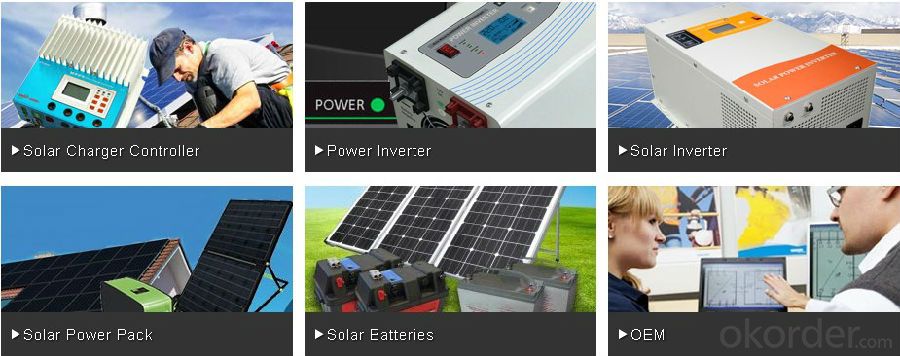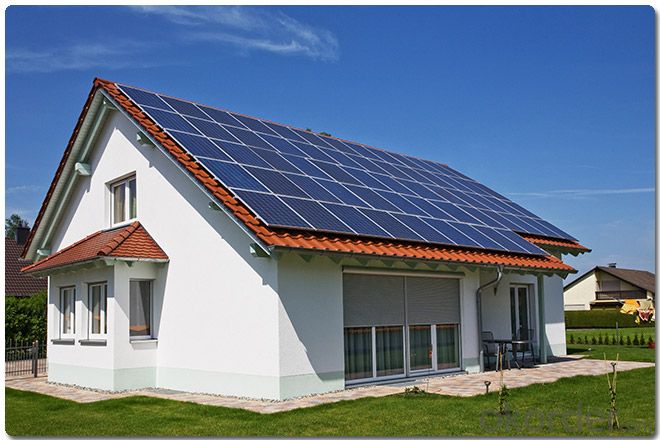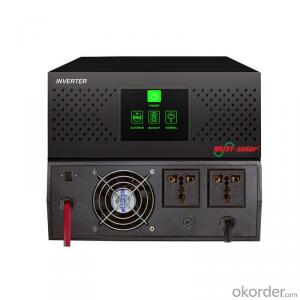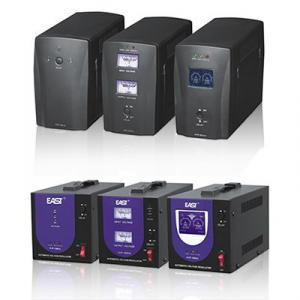Anern Solar Inverter with Excellent Quality 2024 Very Popular New Function
- Loading Port:
- China main port
- Payment Terms:
- TT or LC
- Min Order Qty:
- 50 unit
- Supply Capability:
- 10000 unit/month
OKorder Service Pledge
OKorder Financial Service
You Might Also Like
Pure Sine Wave Inverter EP2000 Series 300W/400W with LED Indication, Single Phase
Features:
This high efficiency microprocessor controlled DC-AC inverter converts 12 Volts DC (Nominal) 300/400Watts of pure sine-wave AC power at 100/120/220/230 Volts, 50/60 Hz.
The unit comes with in-built 7 Amp transfer switch and a 20 Amp circuit breaker.
Input battery cable lugs are provided and the AC output is obtained through hardwire connection.
Features include overload, short circuit, over-temperature, under & over voltage protections, and selectable. emergency home backup.
Safe to use and features over-current, over- temperature and surge protection.
Simply connect the inverter to a battery and plug your AC devices into it, then you’ve got portable power.
Applications:
Can be used with different domestic appliance TV, Refrigerator ,Fan , air conditioner ,induction cooker , micro-wave oven etc .
Specifications:
MODEL | EP2000 Series | 300W | 400W | |
INPUT | Phase | Single | ||
Voltage | 110/120VAC or 220/230/240VAC | |||
Voltage Range | -35% ~ +25% for selected nominal voltage | |||
Frequency | 50Hz / 60Hz ( Auto Sensing) | |||
Frequency Range | 47Hz ~ 65Hz, | |||
OUTPUT | Phase | Single | ||
Voltage(Btt. Mode) | 110/120VAC or 220/230/240VAC | |||
Voltage Regulation(Batt. Mode) | ±3% of selected output voltage | |||
Frequency | 50Hz or 60Hz | |||
Frequency Regulation (Batt. Mode) | Auto Select for 50/60Hz | |||
Output Waveform | Pure sine wave | |||
BATTERY | Battery Type | Sealed ,maintenance-free lead acid | ||
Back up Time (at a PC load with 15"monitor) | Depends on the capacity of the external battery | |||
Charging methdd | Smart pulse charging with two charging modes: | |||
TRANSFER TIME | Typical | <20ms< td=""> | ||
INDICATOR | Led Indicator | manage backup time, balance power loads and prevent UPS overloads | ||
Audible alarm | Normal city power | Green | ||
Backup mode | Red | |||
Overload alarm | Continuous beep | |||
PROTECTION | Full Protection | Discharge, overcharge, and overload protection | ||
PHYSICAL | Dimension, DXWXH (mm) | 312*262*118(mm) | ||
Net Weight (kgs) | 6.5KG | 7.5KG | ||
ENVIRONMENT | Operating Environment | 0~40 Degrees Centigrade, 0~90% relative humidity (non-condensing) | ||
Noise Level | Less than 40dB at 1M | |||



Warrenty
provides a 1~3 year limited warranty (“Warranty”) against defects in materials and workmanship for its Uninterruptible power supply, Power inverter/chargers, Solar charge controllers, Battery Products (“Product”).
The term of this Warranty begins on the Product(s) initial purchase date, or the date of receipt of the Product(s) by the end user, whichever is later. This must be indicated on the invoice, bill of sale, and/or warranty registration card submitted to MUST-Solar. This Warranty applies to the original MUST-Solar Product purchaser, and is transferable only if the Product remains installed in the original use location.
FAQ
1. How do I decide which system is right for me ?
For protection from long outages, include a generator or solar panels in your Must solar system. Shorter outages can be handled by a battery-only system.
2. Where my system will be installed ?
Must solar systems are usually wall-mounted near a home's main electrical (circuit breaker) panel.
3. How do I install my system ?
A must solar backup inverter is connected to a home electric system , we will supply detailed installation manual and videos for our customers .
- Q: After the PV inverter, how to achieve the same period before the network?
- Solar panel simulator: with MPPT function, simulated morning, noon, afternoon, evening, rainy weather, solar panels produced under different conditions in different voltages.
- Q: How does a solar inverter handle voltage unbalance in the grid?
- A solar inverter handles voltage unbalance in the grid by employing its control algorithms to monitor and regulate the output voltage. When the solar inverter detects an unbalanced grid voltage, it adjusts the output voltage accordingly to maintain a balanced supply. This is typically achieved by injecting reactive power or adjusting the phase angle of the output voltage to synchronize it with the grid. By actively managing voltage unbalance, a solar inverter ensures stable and reliable power conversion in the presence of grid voltage fluctuations.
- Q: Can a solar inverter be used with a solar-powered backup generator?
- Certainly, a solar-powered backup generator can indeed be utilized in conjunction with a solar inverter. The solar inverter's primary function is to convert the DC electricity generated by solar panels into AC electricity, which is suitable for powering household appliances and various electrical devices. Conversely, a solar-powered backup generator harnesses solar energy to either charge its batteries or store any surplus electricity. When the solar panels are actively generating electricity, the solar inverter will convert the DC electricity into AC electricity. This AC electricity can then be directly employed within the household or redirected back to the grid, assuming the system is interconnected. Should there be an excess of electricity being produced and the batteries of the solar-powered backup generator are fully charged, the solar inverter has the capability to divert this surplus electricity to other loads or devices. During periods when solar energy is either insufficient or unavailable, the solar-powered backup generator can seamlessly activate and provide the requisite electricity to power the house or recharge the batteries. In such cases, the solar inverter remains responsible for the conversion of the DC electricity generated by the solar-powered backup generator into AC electricity. To summarize concisely, employing a solar inverter alongside a solar-powered backup generator guarantees a continuous supply of electricity, even during instances of limited solar energy availability.
- Q: What is the PV inverter starting voltage
- sine wave becomes narrower and the voltage width in the center of the sine wave is widened and the switching element is always operated in a direction at a certain frequency in a half cycle, A pulse wave train (pseudo sine wave). Then let the pulse wave form a sine wave through a simple filter
- Q: How does a solar inverter protect against short circuits?
- A solar inverter protects against short circuits by incorporating protective devices such as fuses or circuit breakers in its design. These protective devices are designed to detect high current flow caused by a short circuit and quickly interrupt the circuit, preventing any damage or overheating that could occur. Additionally, advanced solar inverters may also include built-in monitoring systems that constantly monitor the electrical parameters and shut down the inverter in case of a short circuit to ensure safety and prevent further damage.
- Q: Can a solar inverter be used in systems with different module tilts?
- Yes, a solar inverter can be used in systems with different module tilts. Solar inverters are designed to convert the DC power generated by solar modules into AC power that can be used in electrical systems. They are typically compatible with a wide range of module tilts and orientations. However, it is important to ensure that the inverter is properly configured to match the specific tilt angles of the solar modules for optimal performance and maximum energy generation.
- Q: Can a solar inverter be used with solar-powered electric fences?
- Yes, a solar inverter can be used with solar-powered electric fences. Solar inverters are commonly used to convert the direct current (DC) energy generated by solar panels into alternating current (AC) energy, which is suitable for powering electric fences. By connecting the solar panels to a solar inverter, the generated solar energy can be efficiently utilized to power the electric fence system.
- Q: Can a solar inverter be used in remote locations?
- Yes, a solar inverter can be used in remote locations. Solar inverters are designed to convert the DC power generated by solar panels into AC power that can be used to power electrical devices. They can be used in off-grid or remote locations where access to a traditional power grid is not available.
- Q: Can a solar inverter be used with a solar-powered data center?
- Yes, a solar inverter can be used with a solar-powered data center. A solar inverter is an essential component that converts the direct current (DC) produced by solar panels into alternating current (AC) that can be used to power electrical equipment, including data centers. By integrating a solar inverter into the solar power system of a data center, the generated solar energy can be efficiently used to run the center's operations, reducing reliance on grid electricity and promoting sustainability.
- Q: Can a solar inverter be used with different types of solar PV systems (roof-mounted, ground-mounted, etc.)?
- Different types of solar PV systems, such as roof-mounted, ground-mounted, and other variations, can utilize a solar inverter. The primary function of a solar inverter is to convert the direct current (DC) electricity produced by solar panels into alternating current (AC) electricity. This converted electricity can be used to power appliances and can also be fed into the electrical grid. The conversion process remains consistent regardless of the type of PV system being used. However, it's crucial to consider that the solar inverter's requirements and specifications may differ depending on the type of PV system. Different PV systems may have varying voltage and power outputs, which may necessitate specific inverter models capable of handling these requirements. For instance, ground-mounted solar systems may have larger arrays and higher power outputs than roof-mounted systems, requiring a different type of inverter. Hence, while a solar inverter can generally be used with various types of solar PV systems, it is essential to select an inverter that is compatible with the specific system's voltage, power output, and other technical specifications. It is always advisable to consult with a professional solar installer or technician to ensure the appropriate selection and installation of the solar inverter for your particular PV system.
Send your message to us
Anern Solar Inverter with Excellent Quality 2024 Very Popular New Function
- Loading Port:
- China main port
- Payment Terms:
- TT or LC
- Min Order Qty:
- 50 unit
- Supply Capability:
- 10000 unit/month
OKorder Service Pledge
OKorder Financial Service
Similar products
Hot products
Hot Searches
Related keywords























